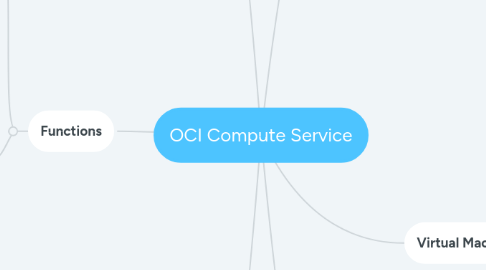
1. Bare Metal(BM)
1.1. You Manage
1.1.1. Code
1.1.2. App Container
1.1.3. Language Runtime
1.1.4. Operating System
1.1.5. Virtualization
1.2. Direct Hardware Access - customer get full bare metal server.
1.3. Single-tenant server
1.4. Off -Box Virtualization
1.4.1. Separate hardware silicon card
1.4.2. Outside in the server
1.5. Use Case
1.5.1. Workloads that are Performance-intensive
1.5.1.1. Database
1.5.2. Workloads that are not virtualized
1.5.3. Workloads that require a specific hypervisor
1.5.3.1. BYOH
1.5.4. Workloads that require BYO Licensing
1.5.4.1. SQL
1.5.4.2. ExCH
2. Virtual Machines(VMs)
2.1. You Manage
2.1.1. Code
2.1.2. App Container
2.1.3. Language Runtime
2.1.4. Operating System
2.1.4.1. OS Patch management
2.1.4.2. Security configuration
2.1.4.3. Monitoring
2.1.4.4. Application Configuration
2.1.4.5. Scaling to handle variable traffic
2.2. A Hypervisor to virtualize the underlying bare metal server into Smaller VMs
2.3. Multi-Tenant VMs
2.4. VM Compute Instance
2.4.1. Runs the same Hardware as a Bare Metal instances
2.4.1.1. Cloud-optimized hardware
2.4.1.2. firmware
2.4.1.3. software stack
2.4.1.4. network infrastructure
2.4.1.5. First class Vms
2.5. Use Case
2.5.1. Control All aspects of an environment
2.5.2. Deploy a Legacy app running on Win or Linux
2.5.3. Move your applications from on-premises to OCI.
3. Container Engine
3.1. You Manage
3.1.1. Code
3.1.2. App Container
3.2. CRI
3.2.1. Docker
3.2.2. Podman
3.3. Deploy
3.3.1. Manually SSh
3.3.1.1. Pror
3.3.1.1.1. Simple
3.3.1.1.2. Easily
3.3.1.2. Con
3.3.1.2.1. Not Automated
3.3.1.2.2. No Reproducible
3.3.1.2.3. Doesn't
3.3.2. Scripting or Config Management Tolls
3.3.2.1. Pro
3.3.2.1.1. Integrate with existing environments
3.3.2.1.2. Easily
3.3.2.2. Con
3.3.2.2.1. Doens't
3.3.2.2.2. No Scheduling Mechanism
3.3.3. Orchestration System
3.3.3.1. Kubernetes STATE OF ART
3.3.3.1.1. Pro
3.3.3.1.2. Con
3.3.3.2. Oracle Kubernetes Enterprise(OKE)
3.3.3.3. Oracle Container Image Registry(OCIR)
3.4. Portable
3.4.1. Any Cloud
3.4.2. Any On-premise
4. Functions
4.1. You Manage
4.1.1. Code
4.2. Serverless
4.2.1. Small unit of compute
4.2.2. Powerful Block
4.2.3. of code that generally
4.2.4. do one simple thing
4.2.5. Lanaguage
4.2.5.1. Java
4.2.5.2. Python
4.2.5.3. Node
4.2.5.4. GO
4.2.5.5. Ruby
4.2.6. Stored Docker Images
4.2.7. Configure Trigger
4.2.8. Code runs only when triggered
4.2.9. Pay for code execution time only
4.2.10. Based FN Platform Open Source
5. Dedicated Virtual Hosts(DVH)
5.1. You Manage
5.1.1. Code
5.1.2. App Container
5.1.3. Language Runtime
5.1.4. Operating System
5.2. Run your VM instances on dedicated bare metal servers.
5.3. Single-Tenant VMs
5.4. Dedicated Full Box
5.5. More Security
6. Instances
6.1. BM
6.2. DVH
6.3. VMs
6.4. Sizes for every workloads
6.4.1. CPU
6.4.1.1. Intel
6.4.1.2. AMD
6.4.1.2.1. 50% cheaper
6.4.1.3. Price/Performance
6.4.2. RAM
6.4.3. BandWidth
6.5. GPU
6.6. HPC
6.7. RDMA
6.8. Depende OCI Services
6.8.1. Boot Volume(OS Disk)
6.8.2. VCN
6.8.2.1. Virtual Network Interface Card(VNIC)
6.8.2.1.1. Private IP
6.8.2.1.2. Public IP
6.8.3. Block Volume(Data disk)
6.9. Scaling
6.9.1. Vertical Scaling
6.9.1.1. Scale-up/Scale-dow
6.9.1.2. New shapes must have the same architecture
6.9.1.3. Downtime is required.
6.9.1.3.1. The instance must be stopped before resize it.
6.9.2. Autosacling
6.9.2.1. Horizontal Scale
6.9.2.1.1. Scale Out/Scale in
6.9.2.2. Gold Image
6.9.2.2.1. Enables large scale deployments os VMs from a single Gold Image with automatic configuration.
6.9.2.3. Use Case
6.9.2.3.1. HA
6.9.2.3.2. Match traffic demand Adding or Removing
6.9.2.4. No Extra Cost
6.9.2.4.1. Pay only per Blck Volume
